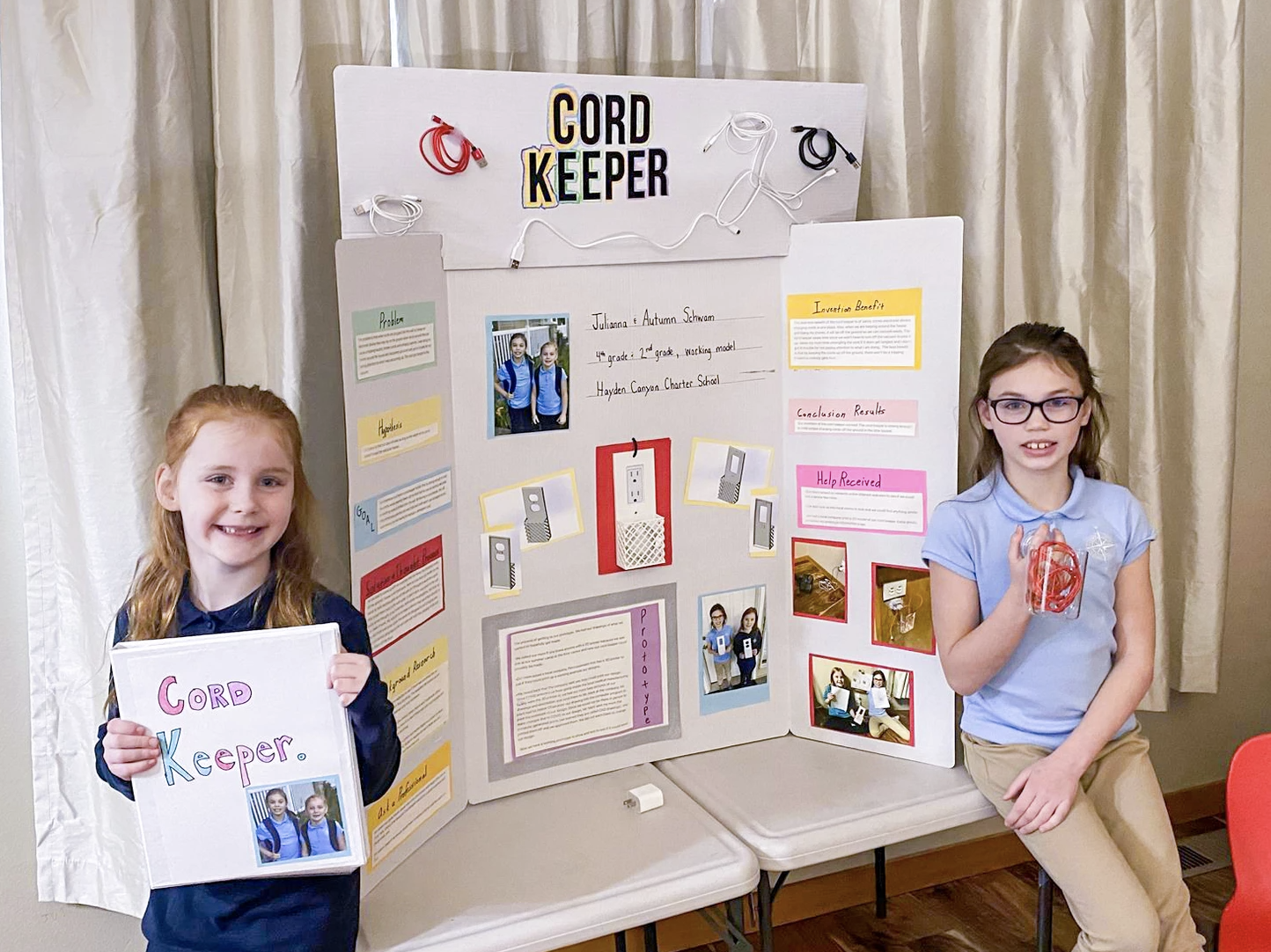The state’s most forward-thinking students submit their inventions for a virtual competition
By Taylor Shillam
Article by Coeur d’Alene Living Local.
Invent Idaho operates with the future in mind, starting with today’s youth. Its mission is to “inspire, encourage and recognize students for their inventions, designs and innovations.”
North Idaho’s premier student invention program began in 1989 and has since impacted countless lives. Invent Idaho provides a platform to students to form valuable connections, build critical skills and find out how far their ideas can take them.
Hosted annually at the University of Idaho, Invent Idaho is the state’s only program of its kind. According to its mission statement, Invent Idaho addresses “dozens of State Science Standards, as well as the number one Technology and Communication Standard, Creativity and Innovation.”
With Idaho schools’ emphasis on STEM education, the organization hopes they can only continue growing.
As many events have in the last year, the 2021 Invent Idaho convention took on a different format from years past. Keeping COVID-19 concerns, restrictions and regulations in mind, Invent Idaho’s regional events were each held and judged virtually. The change didn’t affect its success; in fact, the organization was surprised to see an increase in numbers.
“Even in the midst of a challenging year, our number of participants in Invent Idaho held strong and steady, and our number of participating schools even increased,” shared Beth Brubaker, state director for Invent Idaho.
With the impact of the pandemic affecting the way students learn and interact, “educators and parents are seeking out fresh, innovative pathways for students to engage in learning,” the organization stated.
In 2021, they saw the participant count increase by over 50 inventors compared to last year.
The process behind Invent Idaho begins with students identifying a problem and designing an innovative solution. The student inventors create blueprints, then a prototype of their invention—all while logging their progress in a journal and preparing for the big pitch, a short presentation to explain what they’ve created.
The Inventor’s Journal is a requirement for every participant. In the journal, inventors thoroughly track the entire invention process, starting with the idea and following it through various prototypes to completion.
This year, with all regional events held virtually, each student was asked to record a continuous four- to six-minute video pitch to submit online. Parents were encouraged to let their young inventors complete all the necessary work themselves, except those related to safety and construction. Fresh and innovative only begins to describe the annual competition. The only program in Idaho dedicated to celebrating student creativity and innovation, Invent Idaho simultaneously develops key problem-solving skills within its participants. The program emphasizes an inventive thinking process designed to hone skills in creative thinking, construct knowledge and communication technologies.
In the three events typically held across the state, students participate in progressive levels of the competition. First-, second- and third-place regional winners are chosen alongside a Best of Category and Best of Show, with each winner advancing to the next round. The students’ hard work culminates at the Invent Idaho State Finals.
Participants can contribute projects from a number of categories, with the choice of entering the competition on either an individual or team level. Categories include working models, in which students produce a full-size or scaled working model of their invention that works to accomplish a set goal, and non-working models, for those inventions that would be too large, technical or costly to actually build.
Additional categories include adaptations of inventions already in existence, gadgets and games, and Jules Verne, the fantasy-driven category encompassing projects too “futuristic or fanciful” to be judged amongst the more practical inventions. The Jules Verne category focuses most on originality and imagination, requiring a fully detailed drawing or 3D model to represent the idea.
Participants are divided by grade, with a newly added high school division for grades nine through 12. Invent Idaho focuses on honing skills like higher order thinking, creative thinking and construct knowledge, encouraging innovation, creative engagement, research, math and writing. The impact of the event has reached far beyond the Northwest.
Invent Idaho’s website recalls the success of 2012 participant Carson Magee, who at just 10 years old designed an invention to help those with Type I diabetes, like himself, manage the disease. His project won Best of Show that year, inspiring the publicity that led to the national opportunities.
In 2015, Alex Knoll, a 12-year-old inventor from Post Falls, designed the AbilityApp, a free resource to help people with disabilities locate resources, safe services and employment opportunities. The invention earned him not only multiple awards from Invent Idaho and recognition from other national competitions, but a guest appearance on “The Ellen DeGeneres Show.”
“The Idaho Invention Convention prepares students for the needs of the 21st century economy,” the organization stated. They are proud of empowering a new generation of innovators, critical thinkers and problem solvers.
The student inventors of Invent Idaho are in no shortage of bold, creative ideas.
This year, two groups of students advanced to compete on a national level and earned free patent searches to further develop their inventions, including Autumn and Julianna Schwam from Hayden Canyon Charter. Three student inventors were selected to display their invention at the University of Idaho EXPO alongside the university’s senior engineering design project, including Chelsea Venning with her invention, the Plant Saver.
The Plant Saver is a device that guides a plant into the sunlight until it has reached its required time in the sun, when it’s then rotated back into the shade. Her idea was inspired by watching plants of her own suffer in last summer’s wavering temperatures.
“I want inventions like this to help positively impact the environment and help keep smaller plants alive,” Venning shared. She hopes to continue participating in Invent Idaho throughout high school and eventually reach the world competition, building on her skills and experiences as she gets closer to making her ideas a reality.
Additional 2021 winners include Isabelle Meredith from Lakeland Junior High, who qualified for Nationals with her invention “Famous Monument,” and Ava Shields from Post Falls, Figpickels’ Pick Winner for “Dessert Rush.”
Dessert Rush was inspired by Shields’ love for board games. The game works by rolling a dice to move pieces around the board, collecting recipe ingredients along the way. Creating a game of her own took time, creativity and precision.
“The hardest part of creating this game was designing the cards,” Shields recalled. “I had to create them using extremely exact measurements.” She then had to find just the right print shop to provide color copies of her designs.
The effort invested into creative projects like Ava’s builds a strong foundation for Invent Idaho participants to forge a bright future.
“My goals for the future focus on working hard and accepting that change might be needed at times,” Shields said, reflecting on her finished project. “I hope that inventions like mine will impact the world by giving people everywhere joy and happiness.”
For students, parents and educators ready to learn more about Invent Idaho, the 2020 Invent Idaho Invention Contention State Finals video recording is available for viewing on YouTube. Those looking to get involved can visit InventIdaho.com for information on participation, competition guidelines and sponsorships. Opportunities within Invent Idaho even include free training workshops that can be arranged for students to earn university credit.
Creative thinking and innovation are qualities to celebrate, support and strengthen, especially within the young minds who are preparing to shape the future with their ideas. Invent Idaho is a unique event doing just that: celebrating the creative abilities of our youth.
“We hope all schools will continue to provide the Invent Idaho student invention program for their students, and that new schools, districts and parents will embrace the opportunity,” Brubaker stated. “These young inventors are the future of this country!”


